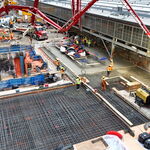robmausser
Senior Member
Will be huge once its connected to the MeadowayThis is taking forever. Really looking forward to the trail to be completed this year!
Will be huge once its connected to the MeadowayThis is taking forever. Really looking forward to the trail to be completed this year!
CC (carbon copy) also to Councillor and Mayor. (These days may have to include a CC to the MPP and Premier, based upon their interference with Toronto).Mr. Lis.......
Don't forget to actually send your comments on design to the people who do the designing!
Fill out the consultation surveys/send emails during the prescribed periods!
Which is also taking its time.Will be huge once its connected to the Meadoway
has the portion from Eglinton Ave to Bermondsey and then Bermondsey to the East Don trail been finalized?Which is also taking its time.
Wow, what Nanaimo is doing is actually quite commendable. The project seen in that link is proabably the closest to Dutch road design of any road I've seen so far in North America.The cycling lanes (and pedestrian sidewalk) in front of driveways should be raised, forcing the motorists to slow down, with yield signs and "sharks teeth". Signs and paint could be ignored, but the raised cycling lanes and sidewalk will give them a jolt, telling them to slow down next time.
From link.
I guess you could set some minimal standards based on vehicular and bicycle traffic that might progress from visual barriers (paint), to soft barriers (Cones, reflective lane channel markers, parking curbs), to permeant physical barriers (fixed curbs and other separations). Some standardization would be useful (as would the treatments of crosswalks, corners etc)
If NYC can have an app that fines idling trucks and financially rewards those that report them. I don’t see why we can’t do that for Toronto bike lane infractions.Went for a nice ride today, Cabbagetown, down Sherbourne to Queen‘s Quay, up through CNE and over the Fort York bridge, up to College, Harbord and Wellesley to home. But the number of cars parked on the bike lanes on Wellesley is frustrating. There ought to be an app where cyclists can report them for enforcement, not statistics.

NYC buses also have the ability to take pictures of any cars in the bus lanes, and for fines to be levied against them.If NYC can have an app that fines idling trucks and financially rewards those that report them. I don’t see why we can’t do that for Toronto bike lane infractions.
You're absolutely right. And whenever someone with a degree of authority steps outside those unspoken local cultural rules, they get punished. Remember several years ago the famous bike cop who patrolled Queens Quay who gleefully doled out tickets to asshole drivers blocking bike lanes, and continuously voiced his frustration over them on Twitter, becoming a local hero in the process because he actually did something about the problem? TPS fired him.It’s always the same in Toronto: do absolutely the minimum half-assed job so that you can’t be accused of inaction, but not enough to actually solve the problem. It’s practically written into the city’s institutional and political DNA - and as citizens we’re ok with it generally, as long as our taxes are low.
Rant mode: off.
It’s generally agreed that enforcement alone is insufficient. You’ll see me (and other posters) here repeatedly saying that changes to road design are necessary. It’s here again, that Toronto’s bureaucratic DNA steps in: it’s expensive so it gets delayed until it’s absolutely necessary, the process still prioritizes traffic flow, and many Councillors don’t advocate hard for it (deferring to Staff, who aren’t incentivized to do more than follow the status quo.)I think the instinct behind speed cameras is wrong. You only succeed in making drivers angry when they get dinged for driving the design speed of a road rather than the (lower) posted speed. I can see how we might be tempted to use speed cameras as a bandaid to calm streets that are designed for too high a speed, but I fear that we will implement speed cameras and rest easy that we solved the problem. We need to systematically redesign streets to match their posted speeds. I especially don't want the city to get accustomed to the revenue and fail to actually make streets better.
Caledonia Road, north of Lawrence Avenue West, is another example. The roadway is designed for the "safety" of speeders doing 60+ km/h or more. However, the posted speed limit is 40 km/h. It is almost impossible to keep at 40 km/h, unless the driver turned on the "cruise control" of the car to stay at 40 km/h.I think the instinct behind speed cameras is wrong. You only succeed in making drivers angry when they get dinged for driving the design speed of a road rather than the (lower) posted speed. I can see how we might be tempted to use speed cameras as a bandaid to calm streets that are designed for too high a speed, but I fear that we will implement speed cameras and rest easy that we solved the problem. We need to systematically redesign streets to match their posted speeds. I especially don't want the city to get accustomed to the revenue and fail to actually make streets better.




